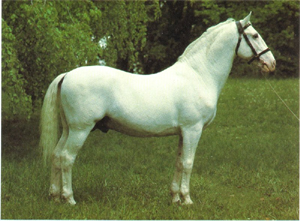Lipizzan Horses

The Lipizzan (or the Lipizzaner as it may sometimes be called) trace their history back to the early 1560's when the finest Arab blood was introduced and fused with the local athletic Spanish horses during the Moorish occupation of Spain. Interest in the art of classical riding revived during the Renaissance period when the Spanish horse was considered the most suitable mount because of his exceptional sturdiness, beauty and intelligence.
The Lipizzan is noted for his sturdy body, brilliant action and proud carriage as well as his intelligent and docile disposition. Born dark, black-brown, brown or mouse-grey, Lipizzans turn white somewhere between the ages of 6 and 10. As mentioned above, only in rare cases does the horse stay the original dark color. Not a tall horse, averaging between 14.3 to 15.3 hands, the Lipizzan presents a very powerful picture. The first thing noticed in the head are the large, appealing eyes. The influence of Arabian blood is found in the head, the small alert ears and the nose. The body, set off by a short powerful neck, presents a picture of strength with well-rounded quarters, heavy shoulders and short, strong legs with well defined tendons and joints. The tail is carried high and, like the mane, is thick and long.
To strengthen the original Spanish-Arab strain, several stallions were purchased during the 18th and 19th centuries for use at Lipizza and Kladrub. During the 1700's these horses, although of Spanish and Italian origin, included sires form Denmark and Holstein, but were of pure Spanish descent. Of all the sires used during the 18th and 19th century, only six of these horses were accepted to found the family lines of the Lipizzan as known today. These Lipizzans are Conversano, Favory, Maestoso, Neapolitano, Pluto, and Siglavy. In addition to the stallions, there are 18 mare family lines. Every stallion has two names, the sire's name and the dam's name. This explains the name such as Pluto Theodorosta.
Grey is the dominate color of the Lipizzan today. Since white horses were preferred by the royal family, the color was stressed in breeding. As late as two hundred years ago, there were a great number of blacks, browns, chestnuts, duns and even piebalds and skewbalds. Today non-white Lipizzans are a rarity and only now and then is a black or bay found.
For additional information on Lipizzan Horses go to this website: